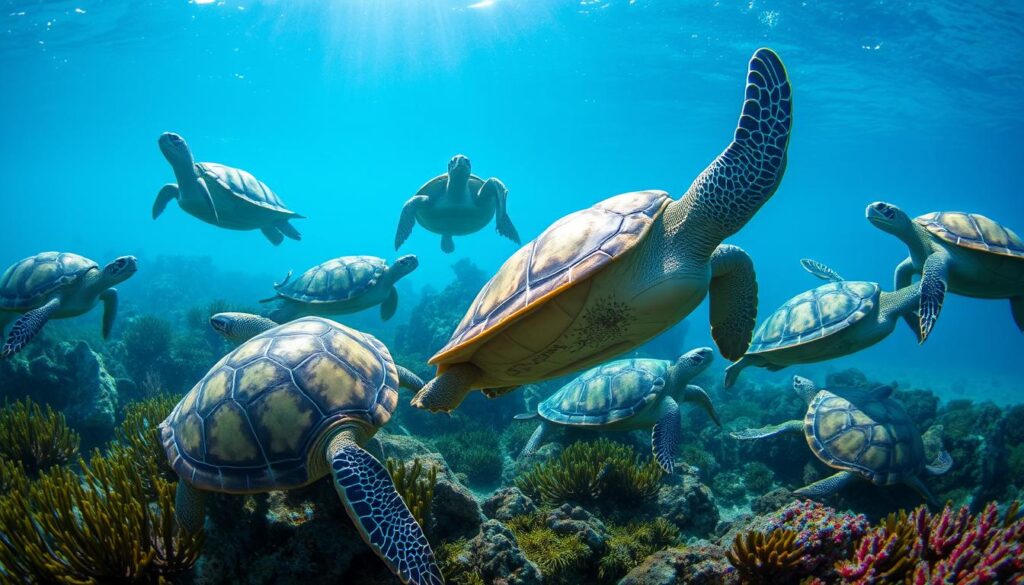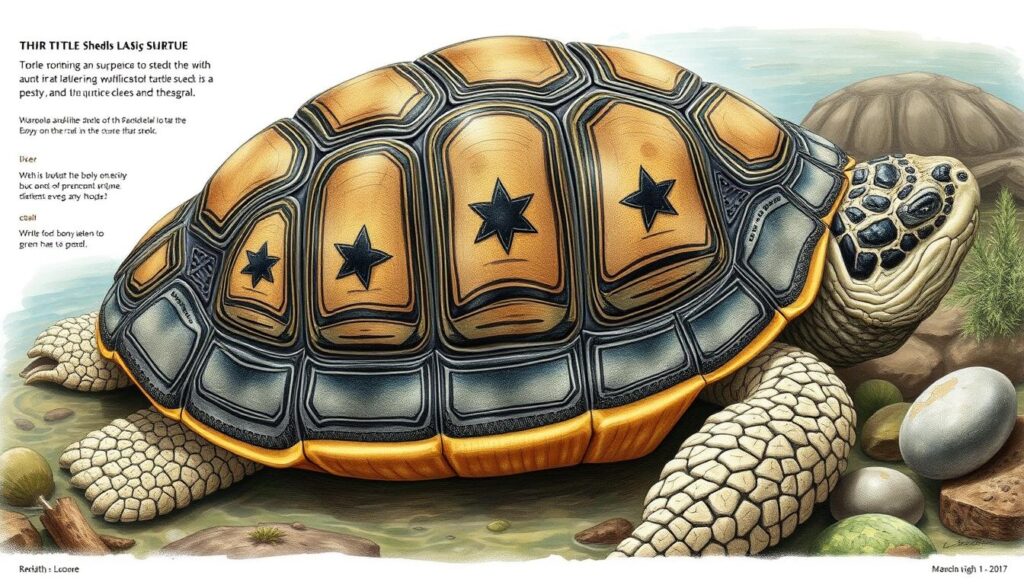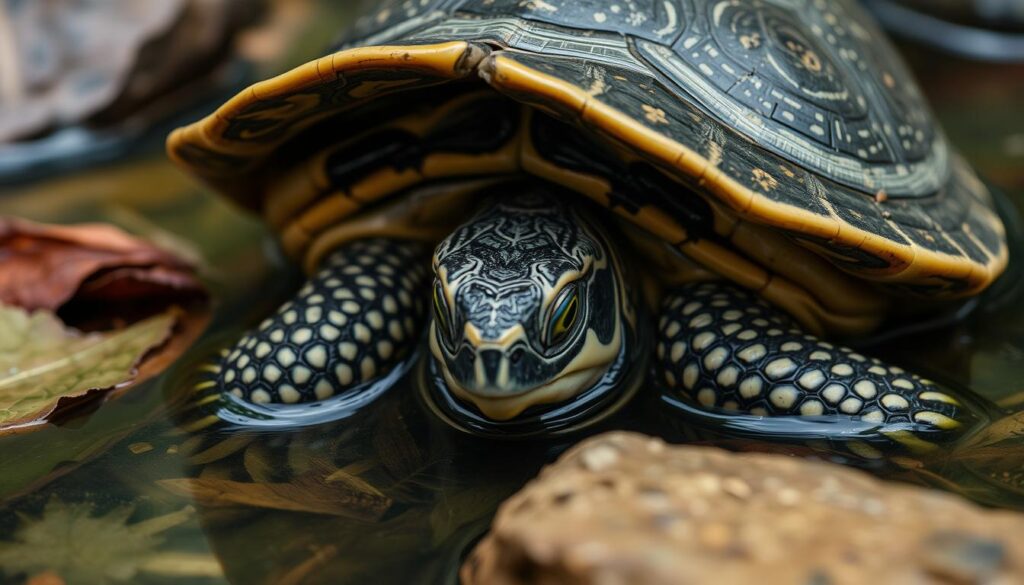
Turtles are fascinating creatures that have captured the imagination of people worldwide. They are part of the reptile classification. This makes them unique compared to other species. With 356 known turtle species, they are diverse and intriguing.
Exploring turtle classification opens up a complex and remarkable world. These resilient reptiles have developed extraordinary survival mechanisms. They can thrive in various environments, from tropical seas to freshwater rivers.
Scientists categorize turtles within the order Testudines. This marks them as distinctive reptiles with iconic protective shells. Their ability to inhabit multiple environments shows their remarkable versatility.
Table of Contents
Understanding the Basics of Turtle Classification
The world of turtle taxonomy is complex and fascinating. The Testudines order is an ancient group of reptiles. They show great diversity and unique traits that have amazed scientists and nature lovers for years.
Definition of Testudines Order
The Testudines order includes all turtles worldwide. There are about 356 different turtle species. They live in many places, from tropical forests to oceans. They are found on every continent except Antarctica, showing their amazing ability to adapt.
Historical Classification Evolution
Turtle taxonomy has changed a lot since it was first studied. German naturalist August Batsch started the first big classification in 1788. He put turtles into groups like Chelonii and Chelonia.
- Early classifications were based on limited observational data
- Taxonomic understanding evolved with advanced research techniques
- Genetic studies provided deeper insights into chelonian classification
Modern Scientific Categorization
Today, turtles are divided into two main groups:
- Cryptodira: Hidden-necked turtles that can fully hide their heads in their shells
- Pleurodira: Side-necked turtles with special ways of folding their necks
“The diversity of turtle species continues to fascinate researchers, offering glimpses into millions of years of evolutionary adaptation.” – Dr. Reptile Researcher
Learning about turtle taxonomy helps us see how amazing and tough these ancient reptiles are. They have survived many global extinction events.
Is a Turtle a Reptile
Turtles are indeed reptiles. They share many traits with snakes, lizards, and crocodiles. This makes them part of the reptile family.
The main turtle characteristics that show they are reptiles include:
- Cold-blooded metabolism
- Scaly skin covering
- Lung-based breathing system
- Egg-laying reproductive strategy
Turtles have been around for over 200 million years. They have evolved unique features while keeping their reptile traits. Their shells are special, but they are still reptiles at heart.
“Turtles represent a remarkable example of evolutionary success within the reptile kingdom.” – Wildlife Research Institute
About 75% of turtles live in water. This shows how well they can adapt. Despite living in different places, they always show their reptile nature.
Learning about turtle classification helps us see how amazing they are. They are complex, well-adapted reptiles that thrive in many places around the world.
Key Features That Make Turtles Reptiles
Turtles have special traits that make them reptiles. These traits set them apart from other animals.
Turtles show three main reptile features. These features confirm they belong to the reptile family:
Cold-Blooded Metabolism
Turtles are ectothermic, meaning they use the environment to control their body heat. They can’t make heat like mammals do. This helps them save energy and live in many places.
- Body temperature matches surrounding environment
- Energy conservation through external heat absorption
- Ability to adapt to various climate conditions
Scaly Body Covering
Turtles have tough, protective scales made of keratin. Keratin is also in human hair and nails. These scales keep them safe from harm.
Lung-Based Breathing System
Turtles breathe only through their lungs. This is different from amphibians. Their lungs help them breathe well and show their advanced evolution.
“Turtles represent a remarkable example of reptilian biological engineering, perfectly adapted to their environments.” – Reptile Research Institute
These traits prove turtles are reptiles. They show turtles have a special place in the animal world.
The Unique Shell Structure of Turtles

Turtles have a remarkable protective feature – their shell. This shell has evolved over 200 million years. It provides a strong defense for these ancient reptiles.
The turtle shell has two main parts: the carapace and the plastron. These parts are not just simple covers. They are complex biological adaptations that show how shells have evolved.
- The carapace forms the domed upper part of the shell
- The plastron creates the flat bottom section
- Together, they enclose the turtle’s body completely
A turtle’s shell is made of about 50 bones fused together. The outer surface has keratin scales called scutes. These scales add more protection. The shape and size of these scutes vary by species and environment.
“Nature’s armor is often more sophisticated than human engineering” – Wildlife Biologist
Different turtles have unique shells for their habitats. For example, softshell and leatherback turtles have special shells. These show how these creatures can adapt to their environments.
Understanding turtle shells is more than just protection. They are complex biological wonders. They show millions of years of evolution.
Distinguishing Turtles from Amphibians
Exploring reptiles and amphibians shows us how turtles and amphibians differ. They might look similar at first, but they have clear differences. These set them apart in the animal world.
Skin Characteristics: A Critical Difference
The main difference is in their skin. Turtles have dry, scaly skin like reptiles. This keeps them dry and protects them. Amphibians have moist skin that lets them breathe and absorb water.
Reproductive Patterns in Reptile Reproduction
How they reproduce is another big difference. Turtles lay eggs on land, covered in hard shells. Amphibians lay eggs in water that hatch into larvae.
- Turtle eggs: Laid on land, protected by shells
- Amphibian eggs: Typically deposited in water
- Reproductive environment: Terrestrial vs aquatic
Breathing Mechanisms and Aquatic Adaptation
Turtles and amphibians breathe differently. Turtles breathe only through lungs their whole lives. Amphibians use gills as young and lungs as adults.
“The diversity of life reveals itself through the unique adaptations of each species.” – Wildlife Biologist
Evolutionary Insights
Turtles split from amphibians about 300 million years ago. Since then, they’ve evolved to live in many places. Their special traits help them survive.
| Characteristic | Turtles | Amphibians |
|---|---|---|
| Skin Type | Dry, Scaly | Moist, Permeable |
| Egg Laying | Land-Based Amniotic | Water-Based Jelly Eggs |
| Breathing | Lungs Throughout Life | Gills and Lungs |
Types of Turtles and Their Habitats
Turtles come in many shapes and sizes, living in different places. They can be found in oceans, forests, and even dry lands. Freshwater turtles, sea turtles, and terrestrial tortoises have special ways to survive.
- Southeastern North America
- South Asia
Turtles live in many kinds of places. Sea turtles swim in huge oceans. Freshwater turtles live in small ponds or big rivers. Terrestrial tortoises are found in deserts or forests.
“Each turtle species has a unique habitat preference, rarely straying beyond its optimal ecosystem.”
These reptiles are very good at living in different places:
| Turtle Species | Habitat | Population Density |
|---|---|---|
| Red-eared Slider | Freshwater | 300 per hectare |
| North American Bog Turtle | Wetlands | 12 or fewer adults per bog |
| Aldabra Giant Tortoise | Indian Ocean Islands | 30-160 per hectare |
Turtles eat different things too. Some sea turtles only eat jellyfish. Others, like freshwater turtles, eat everything. Terrestrial tortoises mostly eat plants. This shows how turtles can live in many places.
Turtle Anatomy and Physical Characteristics
Turtles are fascinating reptiles with unique physical traits. Their anatomy shows amazing diversity, making them stand out in the animal world.
Turtle Skull and Head Structure
The turtle skull is a marvel of evolution. It lacks temporal fenestrae, making it compact. This design offers great protection and allows for unique head movements.
Limb Adaptations for Survival
Turtle limbs are versatile, fitting different habitats. Tortoises have strong feet for walking, while aquatic turtles have webbed toes for swimming. These features help turtles survive in various environments.
Size Variations Across Species
Turtles come in all sizes, from tiny to huge. Here are some size extremes:
- Smallest turtle: Chersobius signatus (3.9 inches)
- Largest living sea turtle: Leatherback (up to 8.9 feet)
- Largest fossil turtle: Archelon (reaching 15 feet)
| Turtle Type | Size Range | Habitat |
|---|---|---|
| Leatherback Sea Turtle | Up to 8.9 feet | Marine |
| Asian Softshell Turtle | Up to 6.5 feet | Freshwater |
| Galápagos Giant Tortoise | 4-5 feet | Terrestrial |
“Nature’s design of turtle anatomy represents millions of years of evolutionary perfection.” – Wildlife Conservation Researcher
Learning about turtles’ physical traits shows their amazing adaptability and survival skills.
Turtle Behavior and Survival Mechanisms
Turtles have developed amazing ways to survive in different places. Their incredible defense mechanisms protect them from predators and harsh environments. The shell is a key shield, allowing many turtles to hide their heads and limbs when danger comes.

How turtles eat varies a lot among species. Some eat plants, while others have unique ways to hunt. For example, the mata mata turtle uses a special vacuum-like method to catch food. A study by graduate student Nicholas Dunham on Blanding’s Turtles shows how complex turtle eating habits can be.
- Shell provides physical protection
- Retractable head and limbs enhance defense
- Diverse feeding strategies across species
Turtle migration is another key survival tactic. Sea turtles are famous for their long journeys. A study on 11 green turtles in San Diego Bay found interesting facts about their travels. Researchers saw:
- Year-round presence in specific habitats
- Complex social interactions
- Adaptive behaviors in urban environments
“Social behaviors among green turtles challenge previous perceptions of their interactions,” notes marine biologist Dr. Emily Asche.
Some turtles can even make sounds to talk to each other. They use special vocal structures for this. These behaviors show how smart and tough these ancient reptiles are.
Conservation Status and Threats
Endangered turtles face many challenges today. Their survival is at risk due to environmental and human pressures. It’s important to understand these threats to help turtles.
Current Population Challenges
Turtle populations are declining. Challenges include:
- Habitat destruction reduces living spaces
- Illegal wildlife trade harms wild populations
- Climate change changes ecosystems
- Agriculture and urban growth split habitats
Protection Efforts
Efforts are underway to save turtles. Organizations are working hard:
- Setting up protected nesting sites
- Creating wildlife corridors
- Starting captive breeding programs
- Creating global conservation agreements
Human Impact
Human actions affect turtles a lot. Habitat destruction is a big threat. Urban growth and farming reduce turtle homes.
“The future of turtle populations depends on our collective conservation efforts” – Wildlife Conservation Experts
| Turtle Species | Conservation Status | Primary Threats |
|---|---|---|
| Bog Turtle | Threatened | Habitat Fragmentation |
| Spotted Turtle | Vulnerable | Wetland Conversion |
| Sea Turtles | Endangered | Fishing Nets, Pollution |
We must keep working to protect turtles. We need science, teamwork, and global efforts.
Turtles as Pets: Care and Requirements
Getting a turtle as a pet is a big step. They are interesting friends that need special care to stay healthy and happy. Before you choose a turtle, you must know what it takes to be a responsible owner.
Each turtle type has its own needs. Aquatic and semi-aquatic turtles are usually 3.5 to 12 inches long. They can live up to 60 years. This means you’re committing to caring for them for a long time.
- Select an appropriate species for your living space
- Prepare a habitat with both water and land areas
- Invest in specialized equipment like UVB lighting and temperature regulators
- Understand specific dietary needs
Setting up the right home for your turtle is key. Here are some important tips:
- Provide 10 gallons of water per inch of shell length
- Maintain basking areas between 85-95 degrees Fahrenheit
- Change water weekly
- Feed adult turtles every 2-3 days
“A turtle is not just a pet, but a long-term companion requiring dedicated care and attention.”
Box turtles, for example, need special care. They need a 40-gallon indoor terrarium, 12 hours of UVB light daily, and about 60% humidity. Their diet should include fresh veggies, fruits, insects, and sometimes low-fat proteins.
Being a responsible owner means knowing your turtle’s needs, caring for them properly, and getting them from trusted sources. This helps protect wild turtles.
Conclusion
Turtle biology tells a story of survival and adaptation. These reptiles have been around for over 200 million years. They show how life can thrive through many changes in the Earth.
From tiny geckos to huge Leatherback Sea Turtles, turtles come in all sizes. They prove that nature can create many different forms of life. This diversity is a testament to life’s ability to survive and adapt.
The evolution of turtles is full of interesting facts. Their shells, long lives, and ability to live in different places make them special. Some turtles, like the Galápagos tortoise, can live over 150 years.
Studying turtles helps us understand their survival secrets. They can change sex based on temperature and live a long time. Their ability to live in many places shows their biological complexity.
Exploring turtle biology is a journey of discovery. It shows us the resilience and wonder of these ancient creatures. Turtles remind us of the amazing diversity and complexity of life on Earth.
FAQ
Are turtles definitely classified as reptiles?
Yes, turtles are definitely reptiles. They have scaly skin, breathe through lungs, and lay eggs on land. These traits match the reptile class, which also includes snakes, lizards, and crocodiles.
How do turtles differ from amphibians?
Turtles and amphibians differ in three main ways. Turtles have dry, scaly skin, while amphibians have moist skin. Turtles lay eggs on land, and amphibians lay eggs in water. Turtles breathe through lungs, while many amphibians use gills as larvae.
What are the main types of turtles?
There are three main types of turtles. Aquatic turtles live in water, tortoises live on land, and terrapins spend time in both. Each type has special adaptations for its habitat, from sea turtles to desert tortoises.
How many turtle species exist?
About 356 turtle species exist worldwide, except Antarctica. They are divided into two suborders: Cryptodira and Pleurodira.
What makes a turtle’s shell unique?
A turtle’s shell is unique. It has a domed carapace and a flat plastron. It’s made of 50-60 bones, with the carapace fused to the vertebrae. The outer surface has scutes, which vary by species.
Are turtles cold-blooded?
Yes, turtles are cold-blooded. Their body temperature changes with the environment. This is a key reptile trait, requiring them to find external heat sources.
Can turtles make sounds?
Some turtles can make sounds for communication. They use vocal cords or other structures. However, their sounds are not as loud as many other animals.
How long have turtles existed?
Turtles have existed for over 220 million years. They’ve survived many mass extinctions and adapted to various environments.
Are turtles endangered?
Many turtles are threatened or endangered. Threats include overharvesting, habitat loss, climate change, and fishing gear. Conservation efforts are needed to protect them.
Can turtles be kept as pets?
Turtles can be pets, but they need specific care. They need large enclosures, proper diet, and temperature control. Owners must research their species’ needs and understand the long-term commitment.

